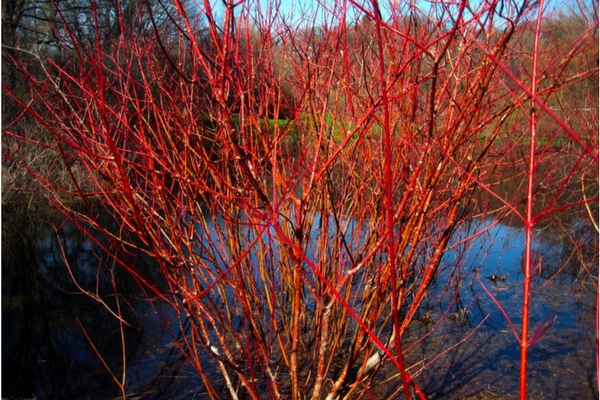Color is highly desired in the winter months. It is hard to find plants for your landscape that have any color besides brown, but something besides green is even harder to find. The dogwoods provide both yellow and red during the winter months.
Redosier Dogwood, Cornus sericea, is also called Red Twig Dogwood. This is a great shrub for year-round interest. It has deep green leaves that turn purplish to reddish in fall and are opposite one another on the twigs. The leaves are oblong with veins that curve around with the leaf edge and have a pointed tip at the leaf end. Redosier Dogwood flowers in late May to early June with flat-topped groups of small, white flowers. This shrub grows up to 8 feet tall and wide and has smooth, red branches to give it interest in the winter months. The fruit is an inedible, small, white berry that appears in the fall and persists into winter.
There are a lot of varieties of Redosier Dogwood to choose from. ‘Flaviramea’ is commonly known as yellow-twig dogwood due to the yellow colored twigs instead of red. ‘Cardinal’ is a large shrub, 8-10 feet tall and wide, that has cherry red stems. For a smaller Red Twig Dogwood, one option is ‘Kelseyi’, which is only 24-30 inches tall and wide. ‘Kelseyi’ is not quite as red as the straight species. ‘Isanti’ is another smaller choice that grows up to 5-6 feet tall and wide and has bright red stems.
Nurseries often interchange Cornus sericea, red twig dogwood and Cornus alba, tatarian dogwood. Both are red twig species with similar growth habits and similar flowering and fruiting characteristics. Tatarian may not sucker or spread as much as redosier. Tatarian dogwood has green stems with a tinge of red throughout the growing season but the stems turn blood red in the winter whereas redosier stems are red throughout the season. Tatarian also stands tighter and more upright compared to the loose, broad-spreading habit of the red twig. These are characteristics that can make a difference in your landscape, so make sure you purchase the correct species when shopping.
Redosier Dogwood is a fast-growing shrub species. It can be cut back to the ground every 3-5 years to keep it healthy and the stems bright red. This form of pruning is called rejuvenation pruning. It is an easy way to renew your shrub to get rid of all the old, unproductive branches that have lost vigor and in turn their red color. Another way to keep the young, healthy branches in your dogwood and maintain the red color is to remove the largest canes from the shrub. Removing these large branches will remove the oldest branches and leave younger, more vigorous branches. This process allows you to keep your shrub at the same height all the time. When removing these large branches, cut them off at ground level and leave the other branches. In this case, only remove 1/3 of the stems each year. If kept up, this second process is easy and doesn’t consume much of your time.
Redosier dogwood will tolerate many different environmental conditions including very wet conditions and shade. According to Michael A. Dirr in the ‘Manual of Woody Landscape Plants’, “Redosier Dogwood does best in moist soil and is often observed in the wild in wet, swampy situations”. Red Twig Dogwood can be planted as a specimen shrub, in a border planting, and as a bank cover to prevent soil erosion. In the winter, red twig dogwood makes an impact to your landscape when planted in contrast to the green background of evergreens.
Red Twig Dogwood is relatively easy to propagate. The seed can be planted after being stratified for 2-3 months at 41 degrees Fahrenheit. Stratification is a process of conditioning for the seed where it must go through a dormant period of cooler temperature before germination will occur. It is also an easy plant to grow from a leaf or stem cutting with a small amount of rooting hormone. Finally, a hardwood cutting can be planted in the late winter directly into the field with good success, according to Michael Dirr.
Redosier Dogwood is a favorite shrub choice among many due to its wonderful winter color. The red becomes quite vibrant in the winter and gives us another color besides brown or white to look at during the drab winter months. It grows fairly fast and in many different environmental locations so it will fit into most any area in your acreage or any other landscape. There are so many different choices on size and color, it is easy to fit Redosier Dogwood into your landscape.

